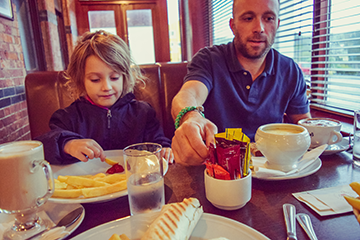
How Can You Dine Out More Healthfully?
Eating Out is Trend That Drives Detrimental Eating Habits
Low prices and locations near schools and high-traffic neighborhoods make fast food restaurants popular and convenient. Fast food is also marketed to children and teens in the midst of their favorite TV shows so it is the first thing they think of when asked what they’d like to eat.
With two working parents, eating out or ordering from fast food restaurants is often what some parents consider to be the “only” choice. Experts took a long look at the impact that this trend has on the health of children and that research triggered the Archives of Pediatric and Adolescent Medicine to publish details of what we’ve summarized here.
Little is Positive About Nutrition Details of Fast Food
• Children (and teens) who eat in fast food restaurants routinely have a significant increase in the intake of sugar, salt and calories.
• Eating in fast food restaurants rather than at home drives their consumption of calories way up. When they eat at full-service restaurants, the extra calorie intake averages 160.
• Sugar intake at both of these types of restaurants not only drives up children’s consumption of sugar-sweetened beverages but reduces their consumption of milk.
• Soda consumption is linked to becoming overweight and an increased risk of type 2 diabetes.
• Foods eaten in fast food and full-service restaurants are associated with increases in sugar, sodium, total fat and saturated fat intakes, all of which are risk factors for overweight, hypertension, and dyslipidemia, components of metabolic syndrome.
• The only positive finding was that for some kids, eating out raised their protein consumption.
Food Journaling Helps You Understand Family Eating Habits
Keeping a food journal can help you capture an accurate picture of where you and your family have strengths and where you need the most help, what your trigger foods are and how you can avoid them and eat more healthfully.
Plan Better to Ensure Better Eating Habits
Packing a school lunch rather than relying on the school cafeteria or, for many older children, on fast food restaurants nearby, is one way to ensure that children and teens are getting food that has less salt, less fat, and less sugar.
By just planning for the weekend and shopping for and cooking a few meals ahead of time, families can avoid the constant restaurant visits. This helps save money in addition to helping the entire family to have a better handle on their weight and overall health.
Here are ten tips for starting a nutritional makeover for your family
1. Know the number of calories that you should be eating and track it. Find out how many calories you need. The USDA’s Daily Food Plan can help you with this.
2. Enjoy your food. Slow the pace of your eating, paying attention to when you’re no longer hungry and knowing when to stop. Don’t just eat until all your food is gone.
3. Use smaller plates, cups, glasses, and bowls and portion food out before sitting down at your table.
4. Eat more vegetables, fruits, whole grains, and low-fat or fat-free dairy foods instead of more meats and carbohydrates. Also use these preferred foods as snacks instead of sugary “treats”.
5. Be sure that half of your plate is filled with fruits and vegetables.
6. Make the switch to low-fat (1%) or fat-free milk.
7. Consume whole grains for more than half of your grain foods.
8. Reduce your consumption of foods that contain solid fats, added sugars, and salt. (ice cream, cookies, candies, sweetened beverages, pizza, and fatty meats). These should NOT be consumed daily.
9. Always read labels and compare the sodium content of foods. Choose those with the lowest amounts.
10. Make water or unsweetened beverages the rule and sugar sweetened beverages the exception.
Choices When You Do Eat Out
Can you actually eat out without undoing all the good you do by cooking at home?
It’s all about choices.
• Choose better restaurants – ones that offer nutritional information with menu choices.
• Limit portions sizes and make milk the rule for children at meals. A good idea for portion control for adults and children is to ask for a doggy bag and bag half of your meal before you begin to eat. This way you won’t over eat.
• Ask questions about menu options and carefully make selections that lead to healthier eating.
• Set the example for your children by eating healthier yourself. They learn from your life example.
The most important thing is to take a thoughtful approach in improving your family’s diet. Being able to sustain your changes and to teach your children to make wise choices on your own is what it will take to make give you your ultimate dietary success.


Conversations